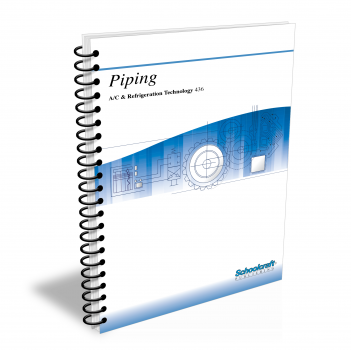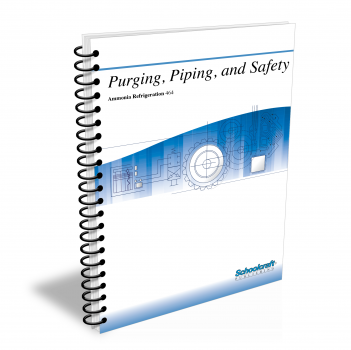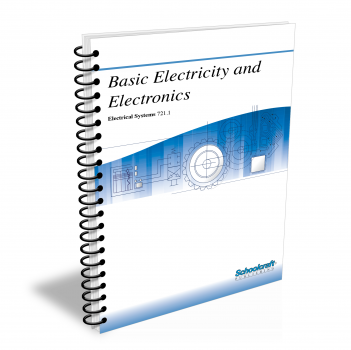Piping

Course Number: 436
The Piping textbook examines piping system materials and sizing, and includes coverage of codes, valves and fittings, and the cutting and joining of piping and tubing. It explains the function and unique requirements of the discharge line, liquid line, and suction line. The textbook concludes with coverage of piping system maintenance, including handling dirt and scale, expansion, vibration, corrosion, and leaks.
Does your curriculum require additional topics not included in this textbook? Build a customized version of the Piping textbook below.
Recommended Contact Hours – 10
Preview a Chapter
Available Supporting Material
- Table of Contents
- Exam Copies
- Suggested Titles
Table of Contents
Chapter 1: Piping Materials and Fittings
Topics: Material compatibility; Sizing; Oil migration; Pipe vs tubing; Schedules and codes; Valves; Fittings; Cutting and joining pipe; Tubing materials and sizes; Cutting, flaring, bending, and joining tubing
Learning Objectives:
- Name the three main lines of piping in a refrigeration system.
- Explain why air conditioning and refrigeration piping must be sized correctly.
- Contrast pipe and tubing and explain why tubing is often preferred over piping.
- Explain how pipe is classified according to schedule.
- Name three methods of joining steel pipe.
- Explain how tubing is cut, flared, bent, and joined.
- Describe the step-by-step procedure for making a brazed joint.
Chapter 2: Discharge Line
Topics: Refrigerant condition; Pressure drop; Oil circulation; Piping layout, sizing; Refrigerant migration; Accessories
Learning Objectives:
- List the four functions of the discharge line in a refrigeration piping system.
- Explain the importance of pressure drop in piping and its effects on system operation.
- Define the term entrainment and explain why entrainment of oil is important.
- State the flow velocity needed for refrigerant vapor to entrain oil in horizontal piping and in vertical risers.
- Name some practical steps you can take to assure a good flow of refrigerant in horizontal piping.
- Describe ways of preventing refrigerant and oil migration to the compressor.
- Name and explain the purposes of three discharge-line accessories.
Chapter 3: Liquid Line
Topics: Refrigerant condition; Pressure drop; Oil circulation; Piping layout and sizing; Liquid receiver; Components, accessories, and insulation
Learning Objectives:
- Name the functions of the liquid line.
- Explain why it is desirable to have subcooling in the liquid line.
- Describe the effects of pressure drop in the liquid line on the operation of a refrigerant system.
- Describe the effects of flash gas formation on the performance of the system.
- Explain the purpose of a liquid receiver.
- Explain why each of the following devices is used in the liquid line: sight glass, solenoid valve, check valve.
Chapter 4: Suction Line
Topics: Lubricating oil; Pressure drop; Accumulators; Heat exchangers; Controls; Valves; Filters; Vibration eliminators; Insulation
Learning Objectives:
- Describe the functions of the suction line, its structural demands, and special design features.
- Explain why suction lines are pitched down toward the compressor.
- Explain how a double suction riser moves oil along with the refrigerant.
- Explain the function of an accumulator and a heat exchanger in a suction line.
- Describe the basic differences between evaporator pressure regulators and crankcase pressure regulators.
- Explain why it is necessary to insulate the suction line.
- Explain how a suction line for multiple compressors differs from a suction line for a single compressor.
Chapter 5: Piping Systems Maintenance
Topics: Dirt and scale; Piping expansion; Supports; Vibration; Corrosion; Leaks; Liquid hammer; Thermal insulation; Troubleshooting
Learning Objectives:
- Name at least four factors that cause piping problems and can lead to operating problems.
- Explain why cleanliness is essential when assembling refrigeration piping.
- Name at least three ways to allow for the expansion of piping.
- Describe the various ways of supporting horizontal and vertical pipe runs.
- Describe the damage that can be caused by vibration and tell how to protect piping from it.
- Define corrosion and explain how it can be prevented in refrigerant and water piping.
- Explain the importance of thermal insulation for refrigeration system piping.
Request Exam Copies
Exam Copies
Ready to see a copy of our textbooks? After selecting which textbooks you’d like to review for your course, you can submit your request by either logging in or creating an account so we know where to ship your exam copies. A representative from Schoolcraft will contact you to confirm and finish processing your request.
Exam copies are always free and yours to keep.
Selected Exam Copies
none selected
* Maximum of five copies can be ordered


